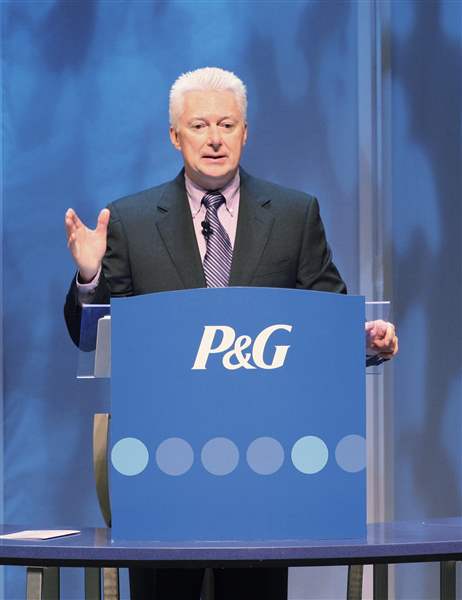
Ex-CEO, 65, to lead Procter & Gamble again
Lafley aims to grow 175-year-old firm
5/25/2013
The Cincinnati company said late Thursday that former CEO A.G. Lafley, a 33-year industry veteran, is returning its top post.
AP

The Cincinnati company said late Thursday that former CEO A.G. Lafley, a 33-year industry veteran, is returning its top post.
NEW YORK — Household products giant Procter & Gamble Co. is hoping its former CEO can work his magic once again.
The Cincinnati company said late Thursday that former CEO A.G. Lafley, a 33-year industry veteran, is returning its top post. The surprise move comes as the world’s largest consumer-products maker tries to spur growth in the face of stiff global competition.
Mr. Lafley, 65, replaces CEO Bob McDonald, effective immediately. Mr. McDonald, who will retire June 30 after a transition period, has served as CEO since 2009.
Mr. Lafley, who led P&G from 2000 to 2009, also is taking the president and chairman titles.
Investors appeared to approve of the move. Procter & Gamble shares rose $3.18, or 4 percent, to $81.88 Friday.
The 175-year-old company’s Tide detergent, Crest toothpaste, and other products can be found in 98 percent of American households. But it is struggling to grow.
In his first stint at the helm, Mr. Lafley helped right an ailing P&G, emphasizing innovation and a “consumer-is-boss” focus.
That included spending more time in personal observation and interviews with consumers.
He also pulled off the blockbuster $57 billion acquisition of the Gillette Co. in 2005, expanding P&G’s reach into male-oriented products with Gillette’s shavers and razors.
Mr. Lafley said the board approached him “very recently” after Mr. McDonald decided to retire and asked him to reclaim the top spot.
“Frankly, duty called,” he said in an interview with the Associated Press.
“A.G.’s track record and his depth of experience at P&G make him uniquely qualified to lead the company forward at this important time,” board director Jim eeeeeeeeMcNerney said.
P&G is known for its premium products that cost more than competitors but are perceived by customers to be of higher quality. But growth for the company has slowed in developed markets such as North America and Europe.
Like many of its rivals, P&G has been expanding into rapidly growing emerging markets such as Latin America, India, and Russia. But there, it has faced tough competition from already entrenched smaller rivals such as Dutch consumer-products maker Unilever and Colgate-Palmolive.
In order to spur growth, P&G has been cutting costs and rolling out new products. The company is in the middle of a belt-tightening plan aimed at saving $10 billion by 2016. And it has introduced new products or brand expansions including Tide Pods single-use laundry pellets, Downy Unstopables, a washer sheet that adds scent to clothes, and a stronger version of Secret deodorant called Clinical Strength.
But investors have been frustrated by the company’s slow revenue growth and stagnant market-share gains globally. The pressure stepped up last July, when activist investor William Ackman took a 1 percent stake. He has been vocal about streamlining operations and improving results.
“It sounds like the board needed a change at the top,” said Bernstein analyst Ali Dibadj. “We thought maybe there would be a little bit more of a test runway for current management, but clearly, frustration was very high.”
P&G last year acknowledged that it had made missteps in some emerging markets — which make up nearly 40 percent of its sales — when it expanded in some product areas too quickly. And it introduced a plan to focus on its 20 biggest new products and its 10 most-profitable emerging markets, which has led to improving market share.
The moves seemed to be working.
In P&G’s most recent January-to-March quarter, net income rose 6 percent to $2.57 billion, as revenue inched up 2 percent to $20.6 billion. But that fell slightly short of analysts’ expectations of $20.72 billion. It also had begun to gain market share in North America. But fourth-quarter guidance was below expectations as the company spent more to market new products.